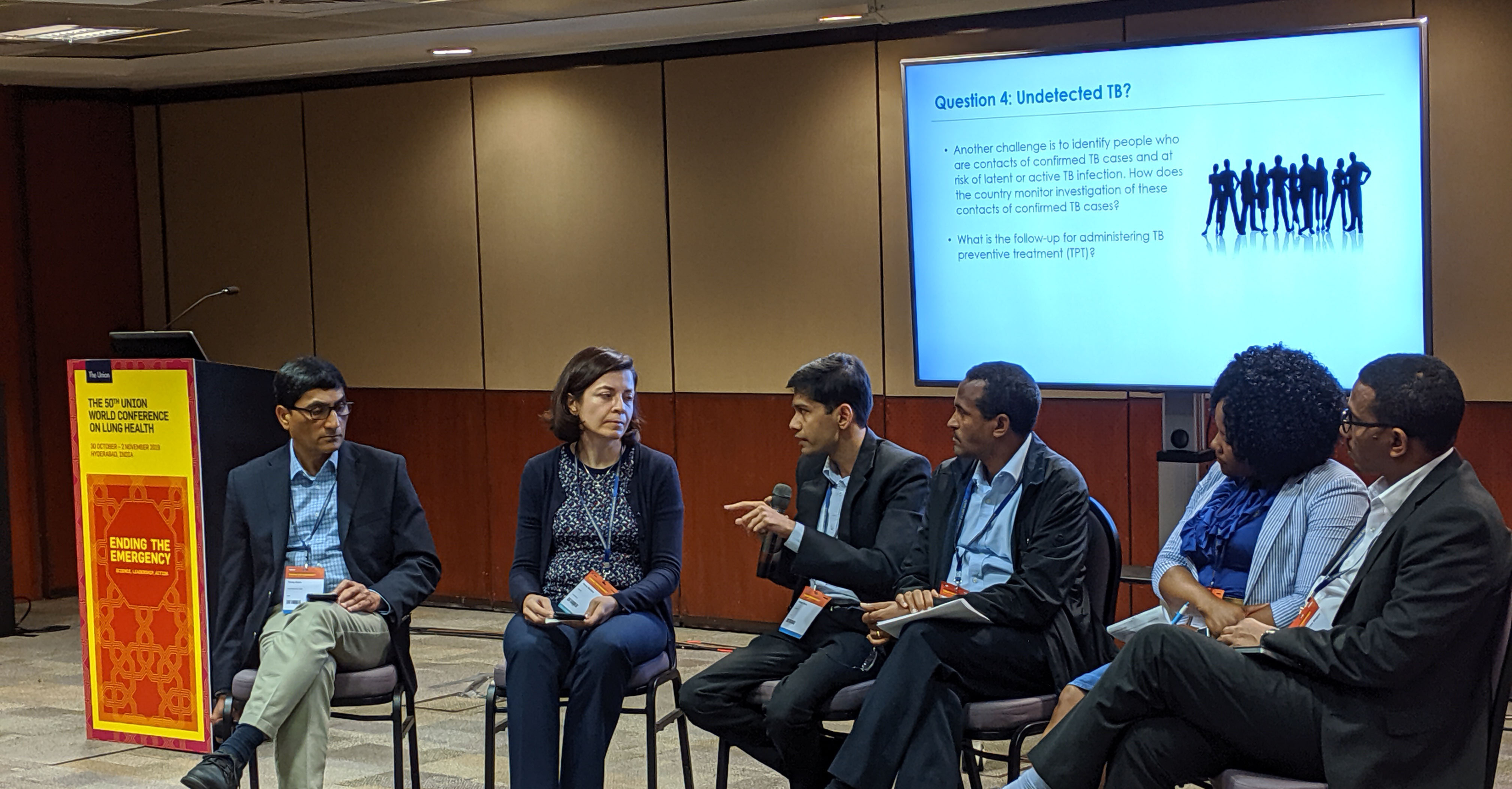
At a major tuberculosis (TB) conference in India, experts from five countries spoke candidly about the kinds of data and analyses that could inform programs to end TB. Speaking at a satellite session during the 50th Union World Conference on Lung Health, in Hyderabad, India, they offered a sharp analysis of indicators for measuring how national TB programs (NTPs) are doing; packaging TB data for analysis and visualization for better decision making; partnering with the private sector so that all people with TB can be reached and treated; and managing the flow of TB data.
The panel session was organized by the TB Data, Impact Assessment and Communications Hub (TB DIAH). TB DIAH is funded by the United States Agency for International Development (USAID) and is part of the agency’s Global Accelerator to End Tuberculosis. TB DIAH helps to ensure optimal demand for and analysis of TB data and the appropriate use of that information to measure performance and inform decision making to end TB.
“We were excited to host this satellite session to introduce TB DIAH to Union Conference attendees and to hear from country-level TB experts about how they use TB data for decision making,” said Stephanie Mullen, DrPH, MPH, TB DIAH’s project director.
Panelists were Zeleke Alebachew, a TB advisor in Ghana; Cindy Dlamini, of the USAID mission in South Africa; Seyoum Dejene, of the USAID mission in Uganda; Amar Shah, of the USAID mission in India; and Anna Meltzer, from the USAID mission in Uzbekistan.
TB indicators and data sharing
Considering what kind of data are best suited to measure the success of national TB programs (NTPs), Alebachew listed six indicators of success: case notification, treatment outcomes, drug-resistant case notification, treatment enrollment, drug-resistant outcomes, and the percentage of new and relapse TB/HIV co-infected patients.
The audience also was interested to know if analyzed data should be shared and with whom. Alebachew said that Ghana does what most countries do and shares data annually with the World Health Organization and biannually with the Global Fund to Fight AIDS, Tuberculosis and Malaria. He added that regional- and national-level data for some key indicators are presented in dashboards and published on the country’s District Health Information Software, version 2 (DHIS2) platform, for those with login access; upon request, the data may be shared with stakeholders or researchers.
Data visualization
Data analysis—especially visualizations of analyzed data—was of special interest at the session. Cindy Dlamini, the panelist from South Africa, said her country has good systems for capturing client-level data. She said that South Africa uses data visualization for aggregated data to show maps of areas where community transmission is probably happening and graphs to monitor TB trends and outcomes, and the country is working on dashboards to help track progress toward achieving the TB 90-90-90 targets. The country also uses disaggregated data of notification of cases by province, gender, age, certain populations (e.g., mineworkers), etc., and cascade analysis to understand the gaps in the TB care cascade.
She said that data visualization has shown where the national program is performing well and has made data users see the value of data for understanding how best practices and effective interventions have translated into good performance that can be scaled up in other districts where performance is suboptimal. Her view of best practice in visualization is that dashboards should be produced weekly or monthly at the facility level to show performance gaps needing attention.
Also useful, she said, are facility-level TB treatment cascade visualizations, because these inform facility staff about the gaps in their TB care and what to focus on to reach desired performance. It would also be good to be able to monitor visually how contributions from community-based interventions are aiding overall facility performance.
Missing TB cases
The conversation also included discussion of reporting requirements and practices for public and private health facilities. Seyoum Dejene, the panelist from Uganda, said his country has learned that data effective for decision making should have the following characteristics:
• Frequency, preferably weekly
• Data that are easy to understand and not just contained in spreadsheets
• Accuracy
• Data that represent at least 80 percent of the country’s cases
He added that the reporting rate from the private sector is not optimal, especially from for-profit, private entities. Of the total number of cases reported, 78 percent are reported by the public sector; 21 percent are from private, nonprofit organizations; and only one percent are from private, for-profit organizations. He said that stronger policies for the private sector and better enforcement of them are needed. Dejene said that assessing reporting rates for sites at the time of license renewal could also play a major role in improving reporting, as could more training to build capacity and use of reporting tools.
The issue of missing people who have TB or who are at risk of acquiring the disease is important. Most reporting tools capture only people who are enrolled in TB treatment, with no requirements to include presumptive cases and confirmed cases not in treatment. Furthermore, a number of sites diagnose TB, but have no capacity to treat it.
Data flow
The panelists asked one another questions about the complexities of entering real-time data, case-based data collection, data interoperability, data confidentiality, and accountability. Anna Meltzer, the panelist from Uzbekistan, explained how her country carries out surveillance for required notification of TB. The country system features three reporting levels (rayon, oblast, and central levels). About 160 peripheral units submit paper forms and reports to intermediate-level facilities and TB dispensaries for aggregation.
TB specialists and trained TB nurses are responsible for data collection and reporting into paper TB registers. A statistician, an epidemiologist, and a data-entry specialist work on data collection and quality control and on entering data in the electronic database at the intermediary, oblast level. Outputs from the electronic database are cross-checked with the paper reports and errors are corrected manually. The national database generates the World Health Organization standard reports on notifications and treatment outcomes.

